SPNS240A October 2014 – June 2015 RM41L232
PRODUCTION DATA.
- 1Device Overview
- 2Revision History
- 3Device Comparison
-
4Terminal Configuration and Functions
- 4.1 PZ QFP Package Pinout (100-Pin)
- 4.2
Terminal Functions
- 4.2.1 High-End Timer (N2HET)
- 4.2.2 Enhanced Quadrature Encoder Pulse Modules (eQEP)
- 4.2.3 General-Purpose Input/Output (GPIO)
- 4.2.4 Controller Area Network Interface Modules (DCAN1, DCAN2)
- 4.2.5 Multibuffered Serial Peripheral Interface (MibSPI1)
- 4.2.6 Standard Serial Peripheral Interface (SPI2)
- 4.2.7 Local Interconnect Network Controller (LIN)
- 4.2.8 Multibuffered Analog-to-Digital Converter (MibADC)
- 4.2.9 System Module
- 4.2.10 Error Signaling Module (ESM)
- 4.2.11 Main Oscillator
- 4.2.12 Test/Debug Interface
- 4.2.13 Flash
- 4.2.14 Core Supply
- 4.2.15 I/O Supply
- 4.2.16 Core and I/O Supply Ground Reference
- 4.3 Output Multiplexing and Control
- 4.4 Special Multiplexed Options
-
5Specifications
- 5.1 Absolute Maximum Ratings
- 5.2 ESD Ratings
- 5.3 Power-On Hours (POH)
- 5.4 Recommended Operating Conditions
- 5.5 Switching Characteristics Over Recommended Operating Conditions for Clock Domains
- 5.6 Wait States Required
- 5.7 Power Consumption
- 5.8 Thermal Resistance Characteristics for PZ
- 5.9 Input/Output Electrical Characteristics
- 5.10 Output Buffer Drive Strengths
- 5.11 Input Timings
- 5.12 Output Timings
-
6System Information and Electrical Specifications
- 6.1 Voltage Monitor Characteristics
- 6.2 Power Sequencing and Power-On Reset
- 6.3 Warm Reset (nRST)
- 6.4 ARM Cortex-R4 CPU Information
- 6.5 Clocks
- 6.6 Clock Monitoring
- 6.7 Glitch Filters
- 6.8 Device Memory Map
- 6.9 Flash Memory
- 6.10 Flash Program and Erase Timings for Program Flash
- 6.11 Flash Program and Erase Timings for Data Flash
- 6.12 Tightly Coupled RAM Interface Module
- 6.13 Parity Protection for Accesses to peripheral RAMs
- 6.14 On-Chip SRAM Initialization and Testing
- 6.15 Vectored Interrupt Manager
- 6.16 Real-Time Interrupt Module
- 6.17 Error Signaling Module
- 6.18 Reset / Abort / Error Sources
- 6.19 Digital Windowed Watchdog
- 6.20 Debug Subsystem
-
7Peripheral Information and Electrical Specifications
- 7.1 Peripheral Legend
- 7.2 Multibuffered 12-Bit Analog-to-Digital Converter
- 7.3 General-Purpose Input/Output
- 7.4 Enhanced High-End Timer (N2HET)
- 7.5 Controller Area Network (DCAN)
- 7.6 Local Interconnect Network Interface (LIN)
- 7.7 Multibuffered / Standard Serial Peripheral Interface
- 7.8 Enhanced Quadrature Encoder (eQEP)
- 8Device and Documentation Support
- 9Mechanical Packaging and Orderable Addendum
Package Options
Mechanical Data (Package|Pins)
- PZ|100
Thermal pad, mechanical data (Package|Pins)
Orderable Information
6 System Information and Electrical Specifications
6.1 Voltage Monitor Characteristics
A voltage monitor is implemented on this device. The purpose of this voltage monitor is to eliminate the requirement for a specific sequence when powering up the core and I/O voltage supplies.
6.1.1 Important Considerations
- The voltage monitor does not eliminate the need of a voltage supervisor circuit to ensure that the device is held in reset when the voltage supplies are out of range.
- The voltage monitor only monitors the core supply (VCC) and the I/O supply (VCCIO). The other supplies are not monitored by the VMON. For example, if the VCCAD or VCCP are supplied from a source different from that for VCCIO, then there is no internal voltage monitor for the VCCAD and VCCP supplies.
6.1.2 Voltage Monitor Operation
The voltage monitor generates the Power Good MCU signal (PGMCU) as well as the I/Os Power Good I/O signal (PGIO) on the device. During power up or power down, the PGMCU and PGIO are driven low when the core or I/O supplies are lower than the specified minimum monitoring thresholds. The PGIO and PGMCU being low isolates the core logic as well as the I/O controls during the power up or power down of the supplies. This allows the core and I/O supplies to be powered up or down in any order.
When the voltage monitor detects a low voltage on the I/O supply, it will assert a power-on reset. When the voltage monitor detects an out-of-range voltage on the core supply, it asynchronously makes all output pins high impedance, and asserts a power-on reset. The voltage monitor is disabled when the device enters a low power mode.
The VMON also incorporates a glitch filter for the nPORRST input. Refer to Section 6.2.3.1 for the timing information on this glitch filter.
Table 6-1 Voltage Monitoring Specifications
| PARAMETER | MIN | TYP | MAX | UNIT | ||
|---|---|---|---|---|---|---|
| VMON | Voltage monitoring thresholds | VCC low - VCC level below this threshold is detected as too low. | 0.75 | 0.9 | 1.13 | V |
| VCC high - VCC level above this threshold is detected as too high. | 1.40 | 1.7 | 2.1 | |||
| VCCIO low - VCCIO level below this threshold is detected as too low. | 1.85 | 2.4 | 2.9 | |||
6.1.3 Supply Filtering
The VMON has the capability to filter glitches on the VCC and VCCIO supplies.
Table 6-2 shows the characteristics of the supply filtering. Glitches in the supply larger than the maximum specification cannot be filtered.
Table 6-2 VMON Supply Glitch Filtering Capability
| PARAMETER | MIN | MAX | UNIT |
|---|---|---|---|
| Width of glitch on VCC that can be filtered | 250 | 1000 | ns |
| Width of glitch on VCCIO that can be filtered | 250 | 1000 | ns |
6.2 Power Sequencing and Power-On Reset
6.2.1 Power-Up Sequence
There is no timing dependency between the ramp of the VCCIO and the VCC supply voltage. The power-up sequence starts with the I/O voltage rising above the minimum I/O supply threshold, (for more details, see Table 6-4), core voltage rising above the minimum core supply threshold, and the release of power-on reset. The high-frequency oscillator will start up first and its amplitude will grow to an acceptable level. The oscillator start-up time is dependent on the type of oscillator and is provided by the oscillator vendor. The different supplies to the device can be powered up in any order.
During power up, the device goes through the sequential phases listed in Table 6-3.
Table 6-3 Power-Up Phases
| Oscillator start-up and validity check | 1032 oscillator cycles |
| eFuse autoload | 1160 oscillator cycles |
| Flash pump power up | 688 oscillator cycles |
| Flash bank power up | 617 oscillator cycles |
| Total | 3497 oscillator cycles |
The CPU reset is released at the end of this sequence and fetches the first instruction from address 0x00000000.
6.2.2 Power-Down Sequence
The different supplies to the device can be powered down in any order.
6.2.3 Power-On Reset: nPORRST
This reset must be asserted by an external circuitry whenever the I/O or core supplies are outside the recommended range. This signal has a glitch filter on it. It also has an internal pulldown.
6.2.3.1 nPORRST Electrical and Timing Requirements
Table 6-4 Electrical Requirements for nPORRST
| NO. | PARAMETER | MIN | MAX | UNIT | |
|---|---|---|---|---|---|
| VCCPORL | VCC low supply level when nPORRST must be active during power up | 0.5 | V | ||
| VCCPORH | VCC high supply level when nPORRST must remain active during power up and become active during power down | 1.14 | V | ||
| VCCIOPORL | VCCIO / VCCP low supply level when nPORRST must be active during power up | 1.1 | V | ||
| VCCIOPORH | VCCIO / VCCP high supply level when nPORRST must remain active during power up and become active during power down | 3.0 | V | ||
| VIL(PORRST) | Low-level input voltage of nPORRST VCCIO > 2.5 V | 0.2 * VCCIO | V | ||
| Low-level input voltage of nPORRST VCCIO < 2.5 V | 0.5 | V | |||
| 3 | tsu(PORRST) | Setup time, nPORRST active before VCCIO and VCCP > VCCIOPORL during power up | 0 | ms | |
| 6 | th(PORRST) | Hold time, nPORRST active after VCC > VCCPORH | 1 | ms | |
| 7 | tsu(PORRST) | Setup time, nPORRST active before VCC < VCCPORH during power down | 2 | µs | |
| 8 | th(PORRST) | Hold time, nPORRST active after VCCIO and VCCP > VCCIOPORH | 1 | ms | |
| 9 | th(PORRST) | Hold time, nPORRST active after VCC < VCCPORL | 0 | ms | |
| tf(nPORRST) | Filter time nPORRST pin; Pulses less than MIN will be filtered out, pulses greater than MAX will generate a reset. |
475 | 2000 | ns | |
 Figure 6-1 nPORRST Timing Diagram
Figure 6-1 nPORRST Timing Diagram
6.3 Warm Reset (nRST)
This is a bidirectional reset signal. The internal circuitry drives the signal low on detecting any device reset condition. An external circuit can assert a device reset by forcing the signal low. On this terminal, the output buffer is implemented as an open drain (drives low only). To ensure an external reset is not arbitrarily generated, TI recommends that an external pullup resistor is connected to this terminal.
This terminal has a glitch filter. It also has an internal pullup
6.3.1 Causes of Warm Reset
Table 6-5 Causes of Warm Reset
| DEVICE EVENT | SYSTEM STATUS FLAG |
|---|---|
| Power-up reset | Exception Status Register, bit 15 |
| Oscillator fail | Global Status Register, bit 0 |
| PLL slip | Global Status Register, bits 8 and 9 |
| Watchdog exception / Debugger reset | Exception Status Register, bit 13 |
| CPU Reset (driven by the CPU STC) | Exception Status Register, bit 5 |
| Software reset | Exception Status Register, bit 4 |
| External reset | Exception Status Register, bit 3 |
6.3.2 nRST Timing Requirements
Table 6-6 nRST Timing Requirements
| MIN | MAX | UNIT | ||
|---|---|---|---|---|
| tv(RST) | Valid time, nRST active after nPORRST inactive | 2256tc(OSC)(1) | ns | |
| Valid time, nRST active (all other system reset conditions) | 32tc(VCLK) | |||
| tf(nRST) | Filter time nRST pin; Pulses less than MIN will be filtered out, pulses greater than MAX will generate a reset |
475 | 2000 | ns |
6.4 ARM Cortex-R4 CPU Information
6.4.1 Summary of ARM Cortex-R4 CPU Features
The features of the ARM Cortex-R4 CPU include:
- An integer unit with integral Embedded ICE-RT logic.
- High-speed Advanced Microprocessor Bus Architecture (AMBA) Advanced eXtensible Interfaces (AXI) for Level two (L2) master and slave interfaces.
- Dynamic branch prediction with a global history buffer, and a 4-entry return stack
- Low interrupt latency.
- Nonmaskable interrupt.
- A Harvard Level one (L1) memory system with:
- Tightly Coupled Memory (TCM) interfaces with support for error correction or parity checking memories
- ARMv7-R architecture Memory Protection Unit (MPU) with 8 regions
- Dual core logic for fault detection in safety-critical applications.
- An L2 memory interface:
- Single 64-bit master AXI interface
- 64-bit slave AXI interface to TCM RAM blocks
- A debug interface to a CoreSight Debug Access Port (DAP).
- Six Hardware Breakpoints
- Two Watchpoints
- A Perfomance Monitoring Unit (PMU)
- A Vectored Interrupt Controller (VIC) port.
For more information on the ARM Cortex-R4 CPU, see www.arm.com.
6.4.2 ARM Cortex-R4 CPU Features Enabled by Software
The following CPU features are disabled on reset and must be enabled by the application if required.
- ECC On Tightly Coupled Memory (TCM) Accesses
- Hardware Vectored Interrupt (VIC) Port
- Memory Protection Unit (MPU)
6.4.3 Dual Core Implementation
The device has two Cortex-R4 cores, where the output signals of both CPUs are compared in the CCM-R4 unit. To avoid common mode impacts the signals of the CPUs to be compared are delayed by 2 clock cycles as shown in Figure 6-3.
The CPUs have a diverse CPU placement given by following requirements:
- Different orientation; for example, CPU1 = "north" orientation, CPU2 = "flip west" orientation
- Dedicated guard ring for each CPU
 Figure 6-2 Dual - CPU Orientation
Figure 6-2 Dual - CPU Orientation
6.4.4 Duplicate clock tree after GCLK
The CPU clock domain is split into two clock trees, one for each CPU, with the clock of the 2nd CPU running at the same frequency and in phase to the clock of CPU1. See Figure 6-3.
6.4.5 ARM Cortex-R4 CPU Compare Module (CCM) for Safety
This device has two ARM Cortex-R4 CPU cores, where the output signals of both CPUs are compared in the CCM-R4 unit. To avoid common mode impacts the signals of the CPUs to be compared are delayed in a different way as shown in Figure 6-3.
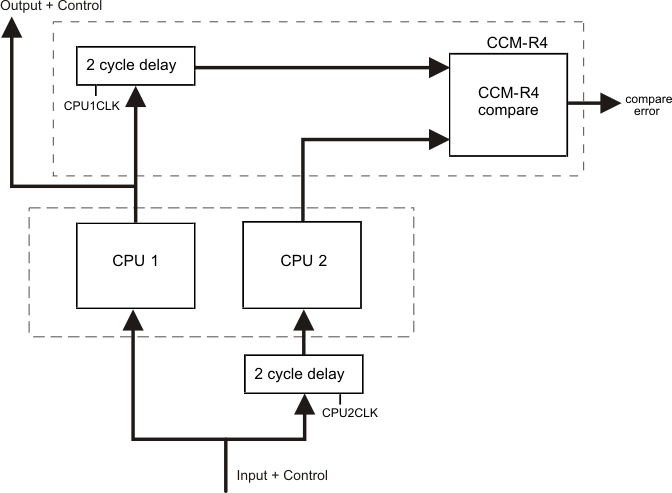 Figure 6-3 Dual Core Implementation
Figure 6-3 Dual Core Implementation
To avoid an erroneous CCM-R4 compare error, the application software must initialize the registers of both CPUs before the registers are used, including function calls where the register values are pushed onto the stack.
6.4.6 CPU Self-Test
The CPU STC (Self-Test Controller) is used to test the two Cortex-R4 CPU Cores using the Deterministic Logic BIST Controller as the test engine.
The main features of the self-test controller are:
- Ability to divide the complete test run into independent test intervals
- Capable of running the complete test or running a few intervals at a time
- Ability to continue from the last executed interval (test set) or to restart from the beginning (first test set)
- Complete isolation of the self-tested CPU core from the rest of the system during the self-test run
- Ability to capture the failure interval number
- Timeout counter for the CPU self-test run as a fail-safe feature
6.4.6.1 Application Sequence for CPU Self-Test
- Configure clock domain frequencies.
- Select the number of test intervals to be run.
- Configure the timeout period for the self-test run.
- Save the CPU state if required
- Enable self-test.
- Wait for CPU reset.
- In the reset handler, read CPU self-test status to identify any failures.
- Retrieve CPU state if required.
For more information, see the RM41x 16/32-Bit RISC Flash Microcontroller Technical Reference Manual (SPNU596).
6.4.6.2 CPU Self-Test Clock Configuration
The maximum clock rate for the self-test is 45 MHz. The STCCLK is divided down from the CPU clock, when necessary. This divider is configured by the STCCLKDIV register at address 0xFFFFE108.
6.4.6.3 CPU Self-Test Coverage
Table 6-7 shows CPU test coverage achieved for each self-test interval. It also lists the cumulative test cycles. The test time can be calculated by multiplying the number of test cycles with the STC clock period.
Table 6-7 CPU Self-Test Coverage
| INTERVALS | TEST COVERAGE, % | TEST CYCLES |
|---|---|---|
| 0 | 0 | 0 |
| 1 | 60.06 | 1365 |
| 2 | 68.71 | 2730 |
| 3 | 73.35 | 4095 |
| 4 | 76.57 | 5460 |
| 5 | 78.7 | 6825 |
| 6 | 80.4 | 8190 |
| 7 | 81.76 | 9555 |
| 8 | 82.94 | 10920 |
| 9 | 83.84 | 12285 |
| 10 | 84.58 | 13650 |
| 11 | 85.31 | 15015 |
| 12 | 85.9 | 16380 |
| 13 | 86.59 | 17745 |
| 14 | 87.17 | 19110 |
| 15 | 87.67 | 20475 |
| 16 | 88.11 | 21840 |
| 17 | 88.53 | 23205 |
| 18 | 88.93 | 24570 |
| 19 | 89.26 | 25935 |
| 20 | 89.56 | 27300 |
| 21 | 89.86 | 28665 |
| 22 | 90.1 | 30030 |
| 23 | 90.36 | 31395 |
| 24 | 90.62 | 32760 |
| 25 | 90.86 | 34125 |
| 26 | 91.06 | 35490 |
6.5 Clocks
6.5.1 Clock Sources
The table below lists the available clock sources on the device. Each of the clock sources can be enabled or disabled using the CSDISx registers in the system module. The clock source number in the table corresponds to the control bit in the CSDISx register for that clock source.
The table also shows the default state of each clock source.
Table 6-8 Available Clock Sources
| CLOCK SOURCE NO. |
NAME | DESCRIPTION | DEFAULT STATE |
|---|---|---|---|
| 0 | OSCIN | Main Oscillator | Enabled |
| 1 | PLL1 | Output From PLL1 | Disabled |
| 2 | Reserved | Reserved | Disabled |
| 3 | EXTCLKIN1 | External Clock Input #1 | Disabled |
| 4 | CLK80K | Low-Frequency Output of Internal Reference Oscillator | Enabled |
| 5 | CLK10M | High-Frequency Output of Internal Reference Oscillator | Enabled |
| 6 | Reserved | Reserved | Disabled |
| 7 | Reserved | Reserved | Disabled |
6.5.1.1 Main Oscillator
The oscillator is enabled by connecting the appropriate fundamental resonator/crystal and load capacitors across the external OSCIN and OSCOUT pins as shown in Figure 6-4. The oscillator is a single stage inverter held in bias by an integrated bias resistor. This resistor is disabled during leakage test measurement and low power modes.
TI strongly encourages each customer to submit samples of the device to the resonator/crystal vendors for validation. The vendors are equipped to determine what load capacitors will best tune their resonator/crystal to the microcontroller device for optimum start-up and operation over temperature/voltage extremes.
An external oscillator source can be used by connecting a 3.3 V clock signal to the OSCIN pin and leaving the OSCOUT pin unconnected (open) as shown in Figure 6-4.
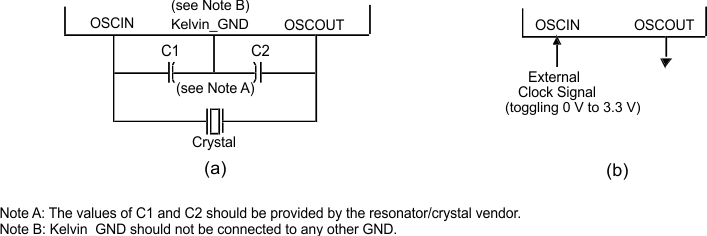 Figure 6-4 Recommended Crystal/Clock Connection
Figure 6-4 Recommended Crystal/Clock Connection
6.5.1.1.1 Timing Requirements for Main Oscillator
Table 6-9 Timing Requirements for Main Oscillator
| PARAMETER | MIN | TYP | MAX | UNIT | |
|---|---|---|---|---|---|
| tc(OSC) | Cycle time, OSCIN (when using a sine-wave input) | 50 | 200 | ns | |
| tc(OSC_SQR) | Cycle time, OSCIN, (when input to the OSCIN is a square wave ) | 50 | 200 | ns | |
| tw(OSCIL) | Pulse duration, OSCIN low (when input to the OSCIN is a square wave) | 15 | ns | ||
| tw(OSCIH) | Pulse duration, OSCIN high (when input to the OSCIN is a square wave) | 15 | ns | ||
6.5.1.2 Low-Power Oscillator
The Low-Power Oscillator (LPO) is comprised of two oscillators — HF LPO and LF LPO.
6.5.1.2.1 Features
The main features of the LPO are:
- Supplies a clock at extremely low power for power-saving modes. This is connected as clock source # 4 of the Global Clock Module.
- Supplies a high-frequency clock for nontiming-critical systems. This is connected as clock source # 5 of the Global Clock Module.
- Provides a comparison clock for the crystal oscillator failure detection circuit.
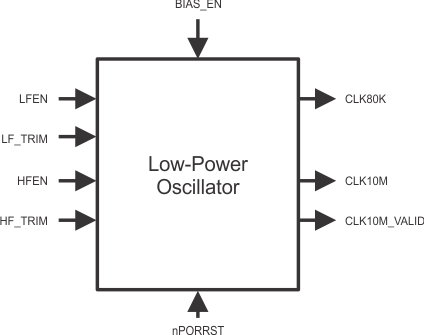 Figure 6-5 LPO Block Diagram
Figure 6-5 LPO Block Diagram
Figure 6-5 shows a block diagram of the internal reference oscillator. This is an LPO and provides two clock sources: one nominally 80 kHz and one nominally 10 MHz.
6.5.1.2.2 LPO Electrical and Timing Specifications
Table 6-10 LPO Specifications
| PARAMETER | MIN | TYP | MAX | UNIT | |
|---|---|---|---|---|---|
| Clock Detection | Oscillator fail frequency - lower threshold, using untrimmed LPO output | 1.375 | 2.4 | 4.875 | MHz |
| Oscillator fail frequency - higher threshold, using untrimmed LPO output | 22 | 38.4 | 78 | ||
| LPO - HF oscillator (fHFLPO) | Untrimmed frequency | 5.5 | 9 | 19.5 | MHz |
| Trimmed frequency | 8 | 9.6 | 11 | MHz | |
| Start-up time from STANDBY (LPO BIAS_EN High for at least 900 µs) | 10 | µs | |||
| Cold start-up time | 900 | µs | |||
| LPO - LF oscillator (fLFLPO) | Untrimmed frequency | 36 | 85 | 180 | kHz |
| Start-up time from STANDBY (LPO BIAS_EN High for at least 900 µs) | 100 | µs | |||
| Cold start-up time | 2000 | µs | |||
6.5.1.3 Phase Locked Loop (PLL) Clock Modules
The PLL is used to multiply the input frequency to some higher frequency.
The main features of the PLL are:
- Frequency modulation can be optionally superimposed on the synthesized frequency of PLL.
- Configurable frequency multipliers and dividers.
- Built-in PLL Slip monitoring circuit.
- Option to reset the device on a PLL slip detection.
6.5.1.3.1 Block Diagram
Figure 6-6 shows a high-level block diagram of the PLL macro on this microcontroller.
 Figure 6-6 PLL Block Diagram
Figure 6-6 PLL Block Diagram
6.5.1.3.2 PLL Timing Specifications
Table 6-11 PLL Timing Specifications
| PARAMETER | MIN | MAX | UNIT | |
|---|---|---|---|---|
| fINTCLK | PLL1 Reference Clock frequency | 1 | 20 | MHz |
| fpost_ODCLK | Post-ODCLK – PLL1 Post-divider input clock frequency | 400 | MHz | |
| fVCOCLK | VCOCLK – PLL1 Output Divider (OD) input clock frequency | 150 | 550 | MHz |
6.5.2 Clock Domains
6.5.2.1 Clock Domain Descriptions
Table 6-12 lists the device clock domains and their default clock sources. The table also shows the system module control register that is used to select an available clock source for each clock domain.
Table 6-12 Clock Domain Descriptions
| CLOCK DOMAIN NAME | DEFAULT CLOCK SOURCE | CLOCK SOURCE SELECTION REGISTER | DESCRIPTION |
|---|---|---|---|
| HCLK | OSCIN | GHVSRC |
|
| GCLK | OSCIN | GHVSRC |
|
| GCLK2 | OSCIN | GHVSRC |
|
| VCLK | OSCIN | GHVSRC |
|
| VCLK2 | OSCIN | GHVSRC |
|
| VCLKA1 | VCLK | VCLKASRC |
|
| RTICLK | VCLK | RCLKSRC |
|
6.5.2.2 Mapping of Clock Domains to Device Modules
Each clock domain has a dedicated functionality as shown in the figure below.
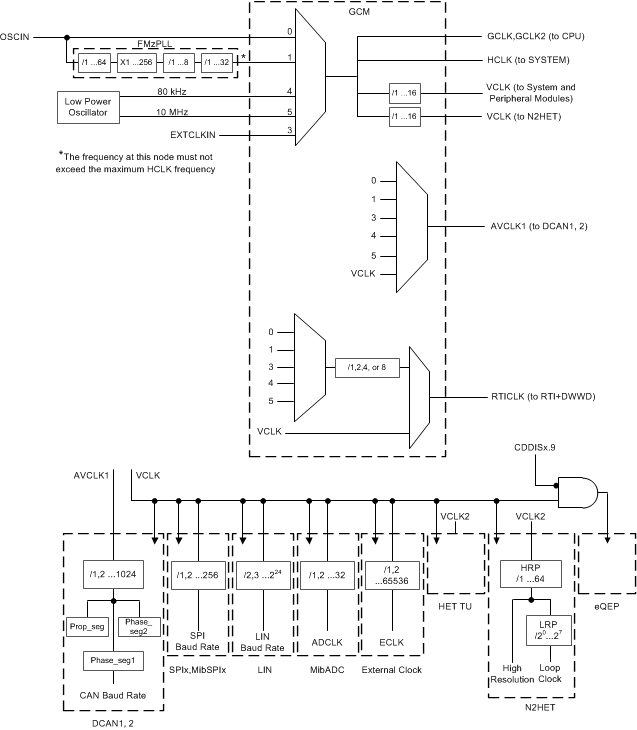 Figure 6-7 Device Clock Domains
Figure 6-7 Device Clock Domains
6.5.3 Clock Test Mode
The RM4x platform architecture defines a special mode that allows various clock signals to be brought out on to the ECLK pin and N2HET[2] device outputs. This mode is called the Clock Test mode. It is very useful for debugging purposes and can be configured through the CLKTEST register in the system module.
Table 6-13 Clock Test Mode Options
| CLKTEST[3-0] | SIGNAL ON ECLK | CLKTEST[11-8] | SIGNAL ON N2HET[2] | |
|---|---|---|---|---|
| 0000 | Oscillator | 0000 | Oscillator Valid Status | |
| 0001 | Main PLL free-running clock output (PLLCLK) | 0001 | Main PLL Valid status | |
| 0010 | Reserved | 0010 | Reserved | |
| 0011 | Reserved | 0011 | Reserved | |
| 0100 | CLK80K | 0100 | Reserved | |
| 0101 | CLK10M | 0101 | CLK10M Valid status | |
| 0110 | Reserved | 0110 | Reserved | |
| 0111 | Reserved | 0111 | Reserved | |
| 1000 | GCLK | 1000 | CLK80K | |
| 1001 | RTI Base | 1001 | Oscillator Valid status | |
| 1010 | Reserved | 1010 | Oscillator Valid status | |
| 1011 | VCLKA1 | 1011 | Oscillator Valid status | |
| 1100 | Reserved | 1100 | Oscillator Valid status | |
| 1101 | Reserved | 1101 | Oscillator Valid status | |
| 1110 | Reserved | 1110 | Oscillator Valid status | |
| 1111 | Flash HD Pump Oscillator | 1111 | Oscillator Valid status |
6.6 Clock Monitoring
The LPO Clock Detect (LPOCLKDET) module consists of a clock monitor (CLKDET) and an internal low-power oscillator (LPO).
The LPO provides two different clock sources – a low frequency (LFLPO) and a high frequency (HFLPO).
The CLKDET is a supervisor circuit for an externally supplied clock signal (OSCIN). In case the OSCIN frequency falls out of a frequency window, the CLKDET flags this condition in the global status register (GLBSTAT bit 0: OSC FAIL) and switches all clock domains sourced by OSCIN to the HFLPO clock (limp mode clock).
The valid OSCIN frequency range is defined as: fHFLPO / 4 < fOSCIN < fHFLPO * 4.
6.6.1 Clock Monitor Timings
For more information on LPO and Clock detection, refer to Table 6-10.
 Figure 6-8 LPO and Clock Detection, Untrimmed HFLPO
Figure 6-8 LPO and Clock Detection, Untrimmed HFLPO
6.6.2 External Clock (ECLK) Output Functionality
The ECLK pin can be configured to output a prescaled clock signal indicative of an internal device clock. This output can be externally monitored as a safety diagnostic.
6.6.3 Dual Clock Comparator
The Dual Clock Comparator (DCC) module determines the accuracy of selectable clock sources by counting the pulses of two independent clock sources (counter 0 and counter 1). If one clock is out of spec, an error signal is generated. For example, the DCC can be configured to use CLK10M as the reference clock (for counter 0) and VCLK as the "clock under test" (for counter 1). This configuration allows the DCC to monitor the PLL output clock when VCLK is using the PLL output as its source.
6.6.3.1 Features
- Takes two different clock sources as input to two independent counter blocks.
- One of the clock sources is the known-good, or reference clock; the second clock source is the "clock under test."
- Each counter block is programmable with initial, or seed values.
- The counter blocks start counting down from their seed values at the same time; a mismatch from the expected frequency for the clock under test generates an error signal which is used to interrupt the CPU.
6.6.3.2 Mapping of DCC Clock Source Inputs
Table 6-14 DCC Counter 0 Clock Sources
| TEST MODE | CLOCK SOURCE [3:0] | CLOCK NAME |
|---|---|---|
| 0 | Others | Oscillator (OSCIN) |
| 0x5 | High-frequency LPO | |
| 0xA | Test clock (TCK) | |
| 1 | X | VCLK |
Table 6-15 DCC Counter 1 Clock Sources
| TEST MODE | KEY [3:0] | CLOCK SOURCE [3:0] | CLOCK NAME |
|---|---|---|---|
| 0 | Others | – | N2HET[31] |
| 0x0 | Main PLL free-running clock output | ||
| 0x1 | n/a | ||
| 0x2 | Low-frequency LPO | ||
| 0xA | 0x3 | High-frequency LPO | |
| 0x4 | Flash HD pump oscillator | ||
| 0x5 | EXTCLKIN | ||
| 0x6 | n/a | ||
| 0x7 | Ring oscillator | ||
| 0x8 - 0xF | VCLK | ||
| 1 | X | X | HCLK |
6.7 Glitch Filters
A glitch filter is present on the following signals.
Table 6-16 Glitch Filter Timing Specifications
| PIN | PARAMETER | MIN | MAX | UNIT | |
|---|---|---|---|---|---|
| nPORRST | tf(nPORRST) |
Filter time nPORRST pin; pulses less than MIN will be filtered out, pulses greater than MAX will generate a reset(1) |
475 | 2000 | ns |
| nRST | tf(nRST) |
Filter time nRST pin; pulses less than MIN will be filtered out, pulses greater than MAX will generate a reset |
475 | 2000 | ns |
| TEST | tf(TEST) |
Filter time TEST pin; pulses less than MIN will be filtered out, pulses greater than MAX will pass through |
475 | 2000 | ns |
6.8 Device Memory Map
6.8.1 Memory Map Diagram
Figure 6-9 shows the device memory map.
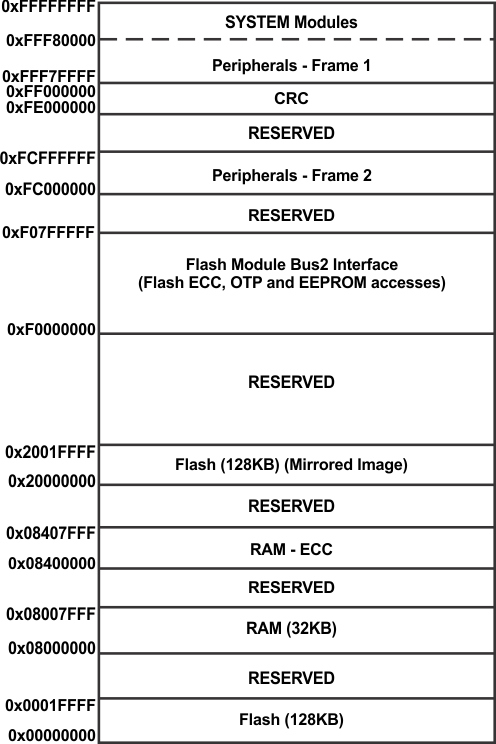 Figure 6-9 RM41LS232 Memory Map
Figure 6-9 RM41LS232 Memory Map
The Flash memory in all configurations is mirrored to support ECC logic testing. The base address of the mirrored Flash image is 0x2000 0000.
6.8.2 Memory Map Table
See Figure 1-1 for a block diagram showing the device interconnects.
Table 6-17 Device Memory Map
| MODULE NAME | FRAME CHIP SELECT |
ADDRESS RANGE | FRAME SIZE |
ACTUAL SIZE |
RESPONSE FOR ACCESS TO UNIMPLEMENTED LOCATIONS IN FRAME | |
|---|---|---|---|---|---|---|
| START | END | |||||
| Memories tightly coupled to the ARM Cortex-R4 CPU | ||||||
| TCM Flash | CS0 | 0x0000_0000 | 0x00FF_FFFF | 16MB | 128KB | Abort |
| TCM RAM + RAM ECC | CSRAM0 | 0x0800_0000 | 0x0BFF_3FFF | 64MB | 32KB | |
| Mirrored Flash | Flash mirror frame | 0x2000_0000 | 0x20FF_FFFF | 16MB | 128KB | |
| Flash Module Bus2 Interface | ||||||
| Customer OTP, TCM Flash Banks | 0xF000_0000 | 0xF000_07FF | 64KB | 2KB | Abort | |
| Customer OTP, EEPROM Bank | 0xF000_E000 | 0xF000_E3FF | 1KB | |||
| Customer OTP–ECC, TCM Flash Banks | 0xF004_0000 | 0xF004_00FF | 8KB | 256B | ||
| Customer OTP–ECC, EEPROM Bank | 0xF004_1C00 | 0xF004_1C7F | 128B | |||
| TI OTP, TCM Flash Banks | 0xF008_0000 | 0xF008_07FF | 64KB | 2KB | ||
| TI OTP, EEPROM Bank | 0xF008_E000 | 0xF008_E3FF | 1KB | |||
| TI OTP–ECC, TCM Flash Banks | 0xF00C_0000 | 0xF00C_00FF | 8KB | 256B | ||
| TI OTP–ECC, EEPROM Bank | 0xF00C_1C00 | 0xF00C_1C7F | 128B | |||
| EEPROM Bank–ECC | 0xF010_0000 | 0xF010_07FF | 256KB | 2KB | ||
| EEPROM Bank | 0xF020_0000 | 0xF020_3FFF | 2MB | 16KB | ||
| Flash Data Space ECC | 0xF040_0000 | 0xF040_DFFF | 1MB | 48KB | ||
| Cyclic Redundancy Checker (CRC) Module Registers | ||||||
| CRC | CRC frame | 0xFE00_0000 | 0xFEFF_FFFF | 16MB | 512B | Accesses above 0x200 generate abort. |
| Peripheral Memories | ||||||
| MIBSPI1 RAM | PCS[7] | 0xFF0E_0000 | 0xFF0F_FFFF | 128KB | 2KB | Abort for accesses above 2KB |
| DCAN2 RAM | PCS[14] | 0xFF1C_0000 | 0xFF1D_FFFF | 128KB | 2KB | Wrap around for accesses to unimplemented address offsets lower than 0x7FF. Abort generated for accesses beyond offset 0x800. |
| DCAN1 RAM | PCS[15] | 0xFF1E_0000 | 0xFF1F_FFFF | 128KB | 2KB | Wrap around for accesses to unimplemented address offsets lower than 0x7FF. Abort generated for accesses beyond offset 0x800. |
| MIBADC RAM | PCS[31] | 0xFF3E_0000 | 0xFF3F_FFFF | 128KB | 8KB | Wrap around for accesses to unimplemented address offsets lower than 0x1FFF. |
| MIBADC Look-Up Table | 384 bytes | Look-up table for ADC wrapper. Starts at offset 0x2000 ans ends at 0x217F. Wrap around for accesses between offsets 0x180 and 0x3FFF. Aborts generated for accesses beyond 0x4000 | ||||
| N2HET RAM | PCS[35] | 0xFF46_0000 | 0xFF47_FFFF | 128KB | 16KB | Wrap around for accesses to unimplemented address offsets lower than 0x3FFF. Abort generated for accesses beyond 0x3FFF. |
| HTU RAM | PCS[39] | 0xFF4E_0000 | 0xFF4F_FFFF | 128KB | 1KB | Abort |
| Debug Components | ||||||
| CoreSight Debug ROM | CSCS0 | 0xFFA0_0000 | 0xFFA0_0FFF | 4KB | 4KB | Reads return zeros, writes have no effect |
| Cortex-R4 Debug | CSCS1 | 0xFFA0_1000 | 0xFFA0_1FFF | 4KB | 4KB | Reads return zeros, writes have no effect |
| Peripheral Control Registers | ||||||
| HTU | PS[22] | 0xFFF7_A400 | 0xFFF7_A4FF | 256B | 256B | Reads return zeros, writes have no effect |
| N2HET | PS[17] | 0xFFF7_B800 | 0xFFF7_B8FF | 256B | 256B | Reads return zeros, writes have no effect |
| GIO | PS[16] | 0xFFF7_BC00 | 0xFFF7_BCFF | 256B | 256B | Reads return zeros, writes have no effect |
| MIBADC | PS[15] | 0xFFF7_C000 | 0xFFF7_C1FF | 512B | 512B | Reads return zeros, writes have no effect |
| DCAN1 | PS[8] | 0xFFF7_DC00 | 0xFFF7_DDFF | 512B | 512B | Reads return zeros, writes have no effect |
| DCAN2 | PS[8] | 0xFFF7_DE00 | 0xFFF7_DFFF | 512B | 512B | Reads return zeros, writes have no effect |
| LIN | PS[6] | 0xFFF7_E400 | 0xFFF7_E4FF | 256B | 256B | Reads return zeros, writes have no effect |
| MibSPI1 | PS[2] | 0xFFF7_F400 | 0xFFF7_F5FF | 512B | 512B | Reads return zeros, writes have no effect |
| SPI2 | PS[2] | 0xFFF7_F600 | 0xFFF7_F7FF | 512B | 512B | Reads return zeros, writes have no effect |
| SPI3 | PS[1] | 0xFFF7_F800 | 0xFFF7_F9FF | 512B | 512B | Reads return zeros, writes have no effect |
| EQEP | PS[25] | 0xFFF7_9900 | 0xFFF7_99FF | 256B | 256B | Reads return zeros, writes have no effect |
| EQEP (Mirrored) | PS2[25] | 0xFCF7_9900 | 0xFCF7_99FF | 256B | 256B | Reads return zeros, writes have no effect |
| System Modules Control Registers and Memories | ||||||
| VIM RAM | PPCS2 | 0xFFF8_2000 | 0xFFF8_2FFF | 4KB | 1KB | Wrap around for accesses to unimplemented address offsets lower than 0x3FF. Accesses beyond 0x3FF will be ignored. |
| Flash Wrapper | PPCS7 | 0xFFF8_7000 | 0xFFF8_7FFF | 4KB | 4KB | Abort |
| eFuse Farm Controller | PPCS12 | 0xFFF8_C000 | 0xFFF8_CFFF | 4KB | 4KB | Abort |
| PCR registers | PPS0 | 0xFFFF_E000 | 0xFFFF_E0FF | 256B | 256B | Reads return zeros, writes have no effect |
| System Module - Frame 2 (see device TRM) | PPS0 | 0xFFFF_E100 | 0xFFFF_E1FF | 256B | 256B | Reads return zeros, writes have no effect |
| PBIST | PPS1 | 0xFFFF_E400 | 0xFFFF_E5FF | 512B | 512B | Reads return zeros, writes have no effect |
| STC | PPS1 | 0xFFFF_E600 | 0xFFFF_E6FF | 256B | 256B | Reads return zeros, writes have no effect |
| IOMM Multiplexing control module | PPS2 | 0xFFFF_EA00 | 0xFFFF_EBFF | 512B | 512B | Generates address error interrupt if enabled. |
| DCC | PPS3 | 0xFFFF_EC00 | 0xFFFF_ECFF | 256B | 256B | Reads return zeros, writes have no effect |
| ESM | PPS5 | 0xFFFF_F500 | 0xFFFF_F5FF | 256B | 256B | Reads return zeros, writes have no effect |
| CCMR4 | PPS5 | 0xFFFF_F600 | 0xFFFF_F6FF | 256B | 256B | Reads return zeros, writes have no effect |
| RAM ECC even | PPS6 | 0xFFFF_F800 | 0xFFFF_F8FF | 256B | 256B | Reads return zeros, writes have no effect |
| RAM ECC odd | PPS6 | 0xFFFF_F900 | 0xFFFF_F9FF | 256B | 256B | Reads return zeros, writes have no effect |
| RTI + DWWD | PPS7 | 0xFFFF_FC00 | 0xFFFF_FCFF | 256B | 256B | Reads return zeros, writes have no effect |
| VIM Parity | PPS7 | 0xFFFF_FD00 | 0xFFFF_FDFF | 256B | 256B | Reads return zeros, writes have no effect |
| VIM | PPS7 | 0xFFFF_FE00 | 0xFFFF_FEFF | 256B | 256B | Reads return zeros, writes have no effect |
| System Module - Frame 1 (see device TRM) | PPS7 | 0xFFFF_FF00 | 0xFFFF_FFFF | 256B | 256B | Reads return zeros, writes have no effect |
6.8.3 Master/Slave Access Privileges
The table below lists the access permissions for each bus master on the device. A bus master is a module that can initiate a read or a write transaction on the device.
Each slave module on the main interconnect is listed in the table. A "Yes" indicates that the module listed in the "MASTERS" column can access that slave module.
Table 6-18 Master / Slave Access Matrix
| MASTERS | ACCESS MODE | SLAVES ON MAIN SCR | |||
|---|---|---|---|---|---|
| Flash Module Bus2 Interface: OTP, ECC, EEPROM Bank |
Non-CPU Accesses to Program Flash and CPU Data RAM | CRC | Peripheral Control Registers, All Peripheral Memories, And All System Module Control Registers And Memories | ||
| CPU READ | User/Privilege | Yes | Yes | Yes | Yes |
| CPU WRITE | User/Privilege | No | Yes | Yes | Yes |
| HTU | Privilege | No | Yes | Yes | Yes |
6.9 Flash Memory
6.9.1 Flash Memory Configuration
Flash Bank: A separate block of logic consisting of 1 to 16 sectors. Each flash bank normally has a customer-OTP and a TI-OTP area. These flash sectors share input/output buffers, data paths, sense amplifiers, and control logic.
Flash Sector: A contiguous region of flash memory which must be erased simultaneously due to physical construction constraints.
Flash Pump: A charge pump which generates all the voltages required for reading, programming, or erasing the flash banks.
Flash Module: Interface circuitry required between the host CPU and the flash banks and pump module.
Note: The memory region from 0x0002_0000 to 0x0003_FFFF is not inherently protected against creating nERROR pin toggles from speculative fetches or from run away code. An MPU region must be used to limit accesses to only the first 128KB of ATCM space (0x0000_0000-0x0001_FFFF). Also, Flash API version 02.01.01 or later should be used to program or erase the flash of this device.
Table 6-19 Flash Memory Banks and Sectors
| MEMORY ARRAYS (or BANKS) | SECTOR NO. |
SEGMENT | LOW ADDRESS | HIGH ADDRESS |
|---|---|---|---|---|
| BANK0 (128KB)(1) | 0 | 8KB | 0x0000_0000 | 0x0000_1FFF |
| 1 | 8KB | 0x0000_2000 | 0x0000_3FFF | |
| 2 | 8KB | 0x0000_4000 | 0x0000_5FFF | |
| 3 | 8KB | 0x0000_6000 | 0x0000_7FFF | |
| 4 | 8KB | 0x0000_8000 | 0x0000_9FFF | |
| 5 | 8KB | 0x0000_A000 | 0x0000_BFFF | |
| 6 | 8KB | 0x0000_C000 | 0x0000_DFFF | |
| 7 | 8KB | 0x0000_E000 | 0x0000_FFFF | |
| 8 | 8KB | 0x0001_0000 | 0x0001_1FFF | |
| 9 | 8KB | 0x0001_2000 | 0x0001_3FFF | |
| 10 | 8KB | 0x0001_4000 | 0x0001_5FFF | |
| 11 | 8KB | 0x0001_6000 | 0x0001_7FFF | |
| 12 | 32KB | 0x0001_8000 | 0x0001_FFFF | |
| BANK7 (16KB) for EEPROM emulation(2)(3) | 0 | 4KB | 0xF020_0000 | 0xF020_0FFF |
| 1 | 4KB | 0xF020_1000 | 0xF020_1FFF | |
| 2 | 4KB | 0xF020_2000 | 0xF020_2FFF | |
| 3 | 4KB | 0xF020_3000 | 0xF020_3FFF |
6.9.2 Main Features of Flash Module
- Support for multiple flash banks for program and/or data storage
- Simultaneous read access on a bank while performing program or erase operation on any other bank
- Integrated state machines to automate flash erase and program operations
- Software interface for flash program and erase operations
- Pipelined mode operation to improve instruction access interface bandwidth
- Support for Single Error Correction Double Error Detection (SECDED) block inside Cortex-R4 CPU
- Error address is captured for host system debugging
- Support for a rich set of diagnostic features
6.9.3 ECC Protection for Flash Accesses
All accesses to the program flash memory are protected by Single Error Correction Double Error Detection (SECDED) logic embedded inside the CPU. The flash module provides 8 bits of ECC code for 64 bits of instructions or data fetched from the flash memory. The CPU calculates the expected ECC code based on the 64 bits received and compares it with the ECC code returned by the flash module. A single-bit error is corrected and flagged by the CPU, while a multibit error is only flagged. The CPU signals an ECC error through its Event bus. This signaling mechanism is not enabled by default and must be enabled by setting the "X" bit of the Performance Monitor Control Register, c9.
MRC p15,#0,r1,c9,c12,#0 ;Enabling Event monitor statesORR r1, r1, #0x00000010MCR p15,#0,r1,c9,c12,#0 ;Set 4th bit (‘X’) of PMNC registerMRC p15,#0,r1,c9,c12,#0
The application must also explicitly enable the CPU's ECC checking for accesses on the CPU's ATCM and BTCM interfaces. These are connected to the program flash and data RAM respectively. ECC checking for these interfaces can be done by setting the B1TCMPCEN, B0TCMPCEN and ATCMPCEN bits of the System Control coprocessor's Auxiliary Control Register, c1.
MRC p15, #0, r1, c1, c0, #1ORR r1, r1, #0x0e000000 ;Enable ECC checking for ATCM and BTCMsDMBMCR p15, #0, r1, c1, c0, #1
6.9.4 Flash Access Speeds
For information on flash memory access speeds and the relevant wait states required, see Section 5.6.
6.10 Flash Program and Erase Timings for Program Flash
Table 6-20 Timing Specifications for Program Flash
| PARAMETER | MIN | NOM | MAX | UNIT | ||
|---|---|---|---|---|---|---|
| tprog (144bit) | Wide Word (144 bit) programming time | 40 | 300 | µs | ||
| tprog (Total) | 384KByte programming time(1) | -40°C to 105°C | 4 | s | ||
| 0°C to 60°C, for first 25 cycles | 1 | 2 | ||||
| terase | Sector/Bank erase time(2) | -40°C to 105°C | 0.30 | 4 | s | |
| 0°C to 60°C, for first 25 cycles | 16 | 100 | ms | |||
| twec | Write/erase cycles with 15 year Data Retention requirement | -40°C to 105°C | 1000 | cycles | ||
6.11 Flash Program and Erase Timings for Data Flash
Table 6-21 Timing Specifications for Data Flash
| PARAMETER | MIN | NOM | MAX | UNIT | ||
|---|---|---|---|---|---|---|
| tprog (72 bit) | Wide Word (72 bit) programming time | 47 | 300 | µs | ||
| tprog (Total) | 16KB programming time(1) | –40°C to 105°C | 330 | ms | ||
| 0°C to 60°C, for first 25 cycles | 100 | 165 | ||||
| terase | Sector/Bank erase time(2) | –40°C to 105°C | 0.200 | 8 | s | |
| 0°C to 60°C, for first 25 cycles | 14 | 100 | ms | |||
| twec | Write/erase cycles with 15 year Data Retention requirement | –40°C to 105°C | 100000 | cycles | ||
6.12 Tightly Coupled RAM Interface Module
Figure 6-10 illustrates the connection of the Tightly Coupled RAM (TCRAM) to the Cortex-R4 CPU.
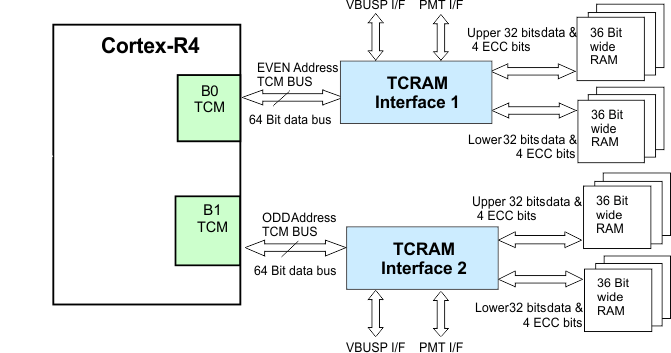 Figure 6-10 TCRAM Block Diagram
Figure 6-10 TCRAM Block Diagram
6.12.1 Features
The features of the Tightly Coupled RAM (TCRAM) module are:
- Acts as slave to the BTCM interface of the Cortex-R4 CPU
- Supports CPU's internal ECC scheme by providing 64-bit data and 8-bit ECC code
- Monitors CPU Event Bus and generates single-bit or multibit error interrupts
- Stores addresses for single-bit and multibit errors
- Provides CPU address bus integrity checking by supporting parity checking on the address bus
- Performs redundant address decoding for the RAM bank chip select and ECC select generation logic
- Provides enhanced safety for the RAM addressing by implementing two 36-bit wide byte-interleaved RAM banks and generating independent RAM access control signals to the two banks
- Supports auto-initialization of the RAM banks along with the ECC bits
- No support for bit-wise RAM accesses
6.12.2 TCRAMW ECC Support
The TCRAMW passes on the ECC code for each data read by the Cortex-R4 CPU from the RAM. It also stores the CPU's ECC port contents in the ECC RAM when the CPU does a write to the RAM. The TCRAMW monitors the CPU's event bus and provides registers for indicating single-bit and multibit errors and also for identifying the address that caused the single-bit or multibit error. The event signaling and the ECC checking for the RAM accesses must be enabled inside the CPU.
For more information see the device Technical Reference Manual.
6.13 Parity Protection for Accesses to peripheral RAMs
Accesses to some peripheral RAMs are protected by odd/even parity checking. During a read access the parity is calculated based on the data read from the peripheral RAM and compared with the good parity value stored in the parity RAM for that peripheral. If any word fails the parity check, the module generates a parity error signal that is mapped to the Error Signaling Module. The module also captures the peripheral RAM address that caused the parity error.
The parity protection for peripheral RAMs is not enabled by default and must be enabled by the application. Each individual peripheral contains control registers to enable the parity protection for accesses to its RAM.
NOTE
The CPU read access gets the actual data from the peripheral. The application can choose to generate an interrupt whenever a peripheral RAM parity error is detected.
6.14 On-Chip SRAM Initialization and Testing
6.14.1 On-Chip SRAM Self-Test Using PBIST
6.14.1.1 Features
- Extensive instruction set to support various memory test algorithms
- ROM-based algorithms allow the application to run TI production-level memory tests
- Independent testing of all on-chip SRAM
6.14.1.2 PBIST RAM Groups
Table 6-22 PBIST RAM Grouping
| MEMORY | RAM GROUP | TEST CLOCK | MEM TYPE | TEST PATTERN (ALGORITHM) | |||
|---|---|---|---|---|---|---|---|
| TRIPLE READ SLOW READ |
TRIPLE READ FAST READ |
MARCH 13N(1)
TWO PORT (CYCLES) |
MARCH 13N(1)
SINGLE PORT (CYCLES) |
||||
| ALGO MASK 0x1 | ALGO MASK 0x2 | ALGO MASK 0x4 | ALGO MASK 0x8 | ||||
| PBIST_ROM | 1 | ROM CLK | ROM | X | X | ||
| STC_ROM | 2 | ROM CLK | ROM | X | X | ||
| DCAN1 | 3 | VCLK | Dual Port | 12720 | |||
| DCAN2 | 4 | VCLK | Dual Port | 6480 | |||
| RAM | 6 | HCLK | Single Port | 133160 | |||
| MIBSPI1 | 7 | VCLK | Dual Port | 33440 | |||
| VIM | 10 | VCLK | Dual Port | 12560 | |||
| MIBADC | 11 | VCLK | Dual Port | 4200 | |||
| N2HET1 | 13 | VCLK | Dual Port | 25440 | |||
| HTU1 | 14 | VCLK | Dual Port | 6480 | |||
The PBIST ROM clock can be divided down from HCLK. The divider is selected by programming the ROM_DIV field of the Memory Self-Test Global Control Register (MSTGCR) at address 0xFFFFFF58.
6.14.2 On-Chip SRAM Auto Initialization
This microcontroller allows some of the on-chip memories to be initialized through the Memory Hardware Initialization mechanism in the System module. This hardware mechanism allows an application to program the memory arrays with error detection capability to a known state based on their error detection scheme (odd/even parity or ECC).
The MINITGCR register enables the memory initialization sequence, and the MSINENA register selects the memories that are to be initialized.
For more information on these registers refer to the device Technical Reference Manual.
The mapping of the different on-chip memories to the specific bits of the MSINENA registers is shown in Table 6-23.
Table 6-23 Memory Initialization
| CONNECTING MODULE | ADDRESS RANGE | MSINENA REGISTER BIT NO.(1) |
|
|---|---|---|---|
| BASE ADDRESS | ENDING ADDRESS | ||
| RAM | 0x08000000 | 0x08007FFF | 0 |
| MIBSPI1 RAM | 0xFF0E0000 | 0xFF0FFFFF | 7(2) |
| DCAN2 RAM | 0xFF1C0000 | 0xFF1DFFFF | 6 |
| DCAN1 RAM | 0xFF1E0000 | 0xFF1FFFFF | 5 |
| MIBADC RAM | 0xFF3E0000 | 0xFF3FFFFF | 8 |
| N2HET RAM | 0xFF460000 | 0xFF47FFFF | 3 |
| HTU RAM | 0xFF4E0000 | 0xFF4FFFFF | 4 |
| VIM RAM | 0xFFF82000 | 0xFFF82FFF | 2 |
6.15 Vectored Interrupt Manager
The vectored interrupt manager (VIM) provides hardware assistance for prioritizing and controlling the many interrupt sources present on this device. Interrupts are caused by events outside of the normal flow of program execution. Normally, these events require a timely response from the central processing unit (CPU); therefore, when an interrupt occurs, the CPU switches execution from the normal program flow to an interrupt service routine (ISR).
6.15.1 VIM Features
The VIM module has the following features:
- Supports 96 interrupt channels.
- Provides programmable priority and enable for interrupt request lines.
- Provides a direct hardware dispatch mechanism for fastest IRQ dispatch.
- Provides two software dispatch mechanisms when the CPU VIC port is not used.
- Index interrupt
- Register vectored interrupt
- Parity protected vector interrupt table against soft errors.
6.15.2 Interrupt Request Assignments
Table 6-24 Interrupt Request Assignments
| MODULES | INTERRUPT SOURCES | DEFAULT VIM INTERRUPT CHANNEL |
|---|---|---|
| ESM | ESM High level interrupt (NMI) | 0 |
| Reserved | Reserved | 1 |
| RTI | RTI compare interrupt 0 | 2 |
| RTI | RTI compare interrupt 1 | 3 |
| RTI | RTI compare interrupt 2 | 4 |
| RTI | RTI compare interrupt 3 | 5 |
| RTI | RTI overflow interrupt 0 | 6 |
| RTI | RTI overflow interrupt 1 | 7 |
| Reserved | Reserved | 8 |
| GIO | GIO interrupt A | 9 |
| N2HET | N2HET level 0 interrupt | 10 |
| HTU | HTU level 0 interrupt | 11 |
| MIBSPI1 | MIBSPI1 level 0 interrupt | 12 |
| LIN | LIN level 0 interrupt | 13 |
| MIBADC | MIBADC event group interrupt | 14 |
| MIBADC | MIBADC sw group 1 interrupt | 15 |
| DCAN1 | DCAN1 level 0 interrupt | 16 |
| SPI2 | SPI2 level 0 interrupt | 17 |
| Reserved | Reserved | 18 |
| Reserved | Reserved | 19 |
| ESM | ESM Low level interrupt | 20 |
| SYSTEM | Software interrupt (SSI) | 21 |
| CPU | PMU interrupt | 22 |
| GIO | GIO interrupt B | 23 |
| N2HET | N2HET level 1 interrupt | 24 |
| HTU | HTU level 1 interrupt | 25 |
| MIBSPI1 | MIBSPI1 level 1 interrupt | 26 |
| LIN | LIN level 1 interrupt | 27 |
| MIBADC | MIBADC sw group 2 interrupt | 28 |
| DCAN1 | DCAN1 level 1 interrupt | 29 |
| SPI2 | SPI2 level 1 interrupt | 30 |
| MIBADC | MIBADC magnitude compare interrupt | 31 |
| Reserved | Reserved | 32-34 |
| DCAN2 | DCAN2 level 0 interrupt | 35 |
| Reserved | Reserved | 36 |
| SPI3 | SPI3 level 0 interrupt | 37 |
| SPI3 | SPI3 level 1 interrupt | 38 |
| Reserved | Reserved | 39-41 |
| DCAN2 | DCAN2 level 1 interrupt | 42 |
| Reserved | Reserved | 43-60 |
| FMC | FSM_DONE interrupt | 61 |
| Reserved | Reserved | 62-79 |
| HWAG | HWA_INT_REQ_H | 80 |
| Reserved | Reserved | 81 |
| DCC | DCC done interrupt | 82 |
| Reserved | Reserved | 83 |
| eQEPINTn | eQEP Interrupt | 84 |
| PBIST | PBIST Done Interrupt | 85 |
| Reserved | Reserved | 86-87 |
| HWAG | HWA_INT_REQ_L | 88 |
| Reserved | Reserved | 89-95 |
NOTE
Address location 0x00000000 in the VIM RAM is reserved for the phantom interrupt ISR entry; therefore only request channels 0..94 can be used and are offset by 1 address in the VIM RAM.
6.16 Real-Time Interrupt Module
The real-time interrupt (RTI) module provides timer functionality for operating systems and for benchmarking code. The RTI module can incorporate several counters that define the timebases needed for scheduling an operating system.
The timers also allow you to benchmark certain areas of code by reading the values of the counters at the beginning and the end of the desired code range and calculating the difference between the values.
6.16.1 Features
The RTI module has the following features:
- Two independent 64 bit counter blocks
- Four configurable compares for generating operating system ticks. Each event can be driven by either counter block 0 or counter block 1.
- Fast enabling/disabling of events
- Two time-stamp (capture) functions for system or peripheral interrupts, one for each counter block
6.16.2 Block Diagrams
Figure 6-11 shows a high-level block diagram for one of the two 64-bit counter blocks inside the RTI module. Both the counter blocks are identical.
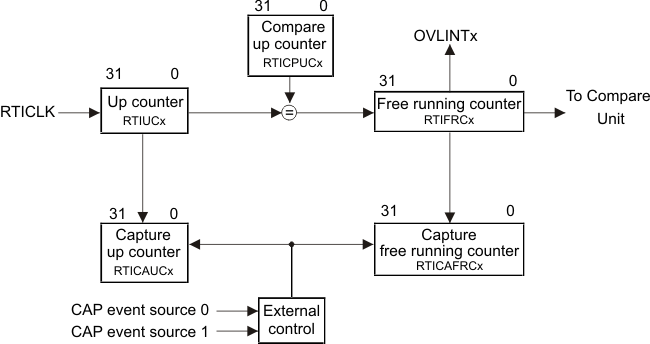 Figure 6-11 Counter Block Diagram
Figure 6-11 Counter Block Diagram
Figure 6-12 shows a typical high-level block diagram for one of the four compares inside the RTI module. Each of the four compares are identical.
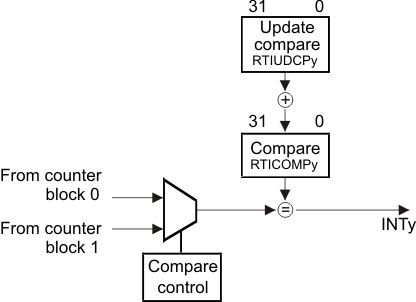 Figure 6-12 Compare Block Diagram
Figure 6-12 Compare Block Diagram
6.16.3 Clock Source Options
The RTI module uses the RTICLK clock domain for generating the RTI time bases.
The application can select the clock source for the RTICLK by configuring the RCLKSRC register in the System module at address 0xFFFFFF50. The default source for RTICLK is VCLK.
For more information, on the clock sources see Table 6-8 and Table 6-12.
6.17 Error Signaling Module
The Error Signaling Module (ESM) manages the various error conditions on the RM4x microcontroller. The error condition is handled based on a fixed severity level assigned to it. Any severe error condition can be configured to drive a low level on a dedicated device terminal called nERROR. This can be used as an indicator to an external monitor circuit to put the system into a safe state.
6.17.1 Features
The features of the Error Signaling Module are:
- 128 interrupt/error channels are supported, divided into 3 different groups
- 64 channels with maskable interrupt and configurable error pin behavior
- 32 error channels with nonmaskable interrupt and predefined error pin behavior
- 32 channels with predefined error pin behavior only
- Error pin to signal severe device failure
- Configurable timebase for error signal
- Error forcing capability
6.17.2 ESM Channel Assignments
The Error Signaling Module (ESM) integrates all the device error conditions and groups them in the order of severity. Group1 is used for errors of the lowest severity while Group3 is used for errors of the highest severity. The device response to each error is determined by the severity group it is connected to. Table 6-26 shows the channel assignment for each group.
Table 6-25 ESM Groups
| ERROR GROUP | INTERRUPT CHARACTERISTICS | INFLUENCE ON ERROR PIN |
|---|---|---|
| Group1 | Maskable, low or high priority | Configurable |
| Group2 | Nonmaskable, high priority | Fixed |
| Group3 | No interrupt generated | Fixed |
Table 6-26 ESM Channel Assignments
| ERROR SOURCES | GROUP | CHANNELS |
|---|---|---|
| Reserved | Group1 | 0 |
| Reserved | Group1 | 1 |
| Reserved | Group1 | 2 |
| Reserved | Group1 | 3 |
| Reserved | Group1 | 4 |
| Reserved | Group1 | 5 |
| FMC - correctable error: bus1 and bus2 interfaces (does not include accesses to EEPROM bank) | Group1 | 6 |
| N2HET - parity | Group1 | 7 |
| HTU - parity | Group1 | 8 |
| HTU - MPU | Group1 | 9 |
| PLL - Slip | Group1 | 10 |
| Clock Monitor - interrupt | Group1 | 11 |
| Reserved | Group1 | 12 |
| Reserved | Group1 | 13 |
| Reserved | Group1 | 14 |
| VIM RAM - parity | Group1 | 15 |
| Reserved | Group1 | 16 |
| MibSPI1 - parity | Group1 | 17 |
| Reserved | Group1 | 18 |
| MibADC - parity | Group1 | 19 |
| Reserved | Group1 | 20 |
| DCAN1 - parity | Group1 | 21 |
| Reserved | Group1 | 22 |
| DCAN2 - parity | Group1 | 23 |
| Reserved | Group1 | 24 |
| Reserved | Group1 | 25 |
| RAM even bank (B0TCM) - correctable error | Group1 | 26 |
| CPU - self-test | Group1 | 27 |
| RAM odd bank (B1TCM) - correctable error | Group1 | 28 |
| Reserved | Group1 | 29 |
| DCC - error | Group1 | 30 |
| CCM-R4 - self-test | Group1 | 31 |
| Reserved | Group1 | 32 |
| Reserved | Group1 | 33 |
| Reserved | Group1 | 34 |
| FMC - correctable error (EEPROM bank access) | Group1 | 35 |
| FMC - uncorrectable error (EEPROM bank access) | Group1 | 36 |
| IOMM - Mux configuration error | Group1 | 37 |
| Reserved | Group1 | 38 |
| Reserved | Group1 | 39 |
| eFuse farm – this error signal is generated whenever any bit in the eFuse farm error status register is set. The application can choose to generate and interrupt whenever this bit is set in order to service any eFuse farm error condition. | Group1 | 40 |
| eFuse farm - self test error. It is not necessary to generate a separate interrupt when this bit gets set. | Group1 | 41 |
| Reserved | Group1 | 42 |
| Reserved | Group1 | 43 |
| Reserved | Group1 | 44 |
| Reserved | Group1 | 45 |
| Reserved | Group1 | 46 |
| Reserved | Group1 | 47 |
| Reserved | Group1 | 48 |
| Reserved | Group1 | 49 |
| Reserved | Group1 | 50 |
| Reserved | Group1 | 51 |
| Reserved | Group1 | 52 |
| Reserved | Group1 | 53 |
| Reserved | Group1 | 54 |
| Reserved | Group1 | 55 |
| Reserved | Group1 | 56 |
| Reserved | Group1 | 57 |
| Reserved | Group1 | 58 |
| Reserved | Group1 | 59 |
| Reserved | Group1 | 60 |
| Reserved | Group1 | 61 |
| Reserved | Group1 | 62 |
| Reserved | Group1 | 63 |
| Reserved | Group2 | 0 |
| Reserved | Group2 | 1 |
| CCMR4 - compare | Group2 | 2 |
| Reserved | Group2 | 3 |
| FMC - uncorrectable error (address parity on bus1 accesses) | Group2 | 4 |
| Reserved | Group2 | 5 |
| RAM even bank (B0TCM) - uncorrectable error | Group2 | 6 |
| Reserved | Group2 | 7 |
| RAM odd bank (B1TCM) - uncorrectable error | Group2 | 8 |
| Reserved | Group2 | 9 |
| RAM even bank (B0TCM) - address bus parity error | Group2 | 10 |
| Reserved | Group2 | 11 |
| RAM odd bank (B1TCM) - address bus parity error | Group2 | 12 |
| Reserved | Group2 | 13 |
| Reserved | Group2 | 14 |
| Reserved | Group2 | 15 |
| TCM - ECC live lock detect | Group2 | 16 |
| Reserved | Group2 | 17 |
| Reserved | Group2 | 18 |
| Reserved | Group2 | 19 |
| Reserved | Group2 | 20 |
| Reserved | Group2 | 21 |
| Reserved | Group2 | 22 |
| Reserved | Group2 | 23 |
| RTI_WWD_NMI | Group2 | 24 |
| Reserved | Group2 | 25 |
| Reserved | Group2 | 26 |
| Reserved | Group2 | 27 |
| Reserved | Group2 | 28 |
| Reserved | Group2 | 29 |
| Reserved | Group2 | 30 |
| Reserved | Group2 | 31 |
| Reserved | Group3 | 0 |
| eFuse Farm - autoload error | Group3 | 1 |
| Reserved | Group3 | 2 |
| RAM even bank (B0TCM) - ECC uncorrectable error | Group3 | 3 |
| Reserved | Group3 | 4 |
| RAM odd bank (B1TCM) - ECC uncorrectable error | Group3 | 5 |
| Reserved | Group3 | 6 |
| FMC - uncorrectable error: bus1 and bus2 interfaces (does not include address parity error and errors on accesses to EEPROM bank) | Group3 | 7 |
| Reserved | Group3 | 8 |
| Reserved | Group3 | 9 |
| Reserved | Group3 | 10 |
| Reserved | Group3 | 11 |
| Reserved | Group3 | 12 |
| Reserved | Group3 | 13 |
| Reserved | Group3 | 14 |
| Reserved | Group3 | 15 |
| Reserved | Group3 | 16 |
| Reserved | Group3 | 17 |
| Reserved | Group3 | 18 |
| Reserved | Group3 | 19 |
| Reserved | Group3 | 20 |
| Reserved | Group3 | 21 |
| Reserved | Group3 | 22 |
| Reserved | Group3 | 23 |
| Reserved | Group3 | 24 |
| Reserved | Group3 | 25 |
| Reserved | Group3 | 26 |
| Reserved | Group3 | 27 |
| Reserved | Group3 | 28 |
| Reserved | Group3 | 29 |
| Reserved | Group3 | 30 |
| Reserved | Group3 | 31 |
6.18 Reset / Abort / Error Sources
Table 6-27 Reset/Abort/Error Sources
| ERROR SOURCE | SYSTEM MODE | ERROR RESPONSE | ESM HOOKUP GROUP.CHANNEL |
|---|---|---|---|
| CPU TRANSACTIONS | |||
| Precise write error (NCNB/Strongly Ordered) | User/Privilege | Precise Abort (CPU) | n/a |
| Precise read error (NCB/Device or Normal) | User/Privilege | Precise Abort (CPU) | n/a |
| Imprecise write error (NCB/Device or Normal) | User/Privilege | Imprecise Abort (CPU) | n/a |
| Illegal instruction | User/Privilege | Undefined Instruction Trap (CPU)(1) | n/a |
| MPU access violation | User/Privilege | Abort (CPU) | n/a |
| SRAM | |||
| B0 TCM (even) ECC single error (correctable) | User/Privilege | ESM | 1.26 |
| B0 TCM (even) ECC double error (noncorrectable) | User/Privilege | Abort (CPU), ESM → nERROR | 3.3 |
| B0 TCM (even) uncorrectable error (that is, redundant address decode) | User/Privilege | ESM → NMI → nERROR | 2.6 |
| B0 TCM (even) address bus parity error | User/Privilege | ESM → NMI → nERROR | 2.10 |
| B1 TCM (odd) ECC single error (correctable) | User/Privilege | ESM | 1.28 |
| B1 TCM (odd) ECC double error (noncorrectable) | User/Privilege | Abort (CPU), ESM → nERROR | 3.5 |
| B1 TCM (odd) uncorrectable error (that is, redundant address decode) | User/Privilege | ESM → NMI → nERROR | 2.8 |
| B1 TCM (odd) address bus parity error | User/Privilege | ESM → NMI → nERROR | 2.12 |
| FLASH WITH CPU BASED ECC | |||
| FMC correctable error - Bus1 and Bus2 interfaces (does not include accesses to EEPROM bank) | User/Privilege | ESM | 1.6 |
| FMC uncorrectable error - Bus1 accesses (does not include address parity error) |
User/Privilege | Abort (CPU), ESM → nERROR | 3.7 |
| FMC uncorrectable error - Bus2 accesses (does not include address parity error and EEPROM bank accesses) |
User/Privilege | ESM → nERROR | 3.7 |
| FMC uncorrectable error - address parity error on Bus1 accesses | User/Privilege | ESM → NMI → nERROR | 2.4 |
| FMC correctable error - Accesses to EEPROM bank | User/Privilege | ESM | 1.35 |
| FMC uncorrectable error - Accesses to EEPROM bank | User/Privilege | ESM | 1.36 |
| HIGH-END TIMER TRANSFER UNIT (HTU) | |||
| NCNB (Strongly Ordered) transaction with slave error response | User/Privilege | Interrupt → VIM | n/a |
| External imprecise error (Illegal transaction with ok response) | User/Privilege | Interrupt → VIM | n/a |
| Memory access permission violation | User/Privilege | ESM | 1.9 |
| Memory parity error | User/Privilege | ESM | 1.8 |
| N2HET | |||
| Memory parity error | User/Privilege | ESM | 1.7 |
| MIBSPI | |||
| MibSPI1 memory parity error | User/Privilege | ESM | 1.17 |
| MIBADC | |||
| MibADC Memory parity error | User/Privilege | ESM | 1.19 |
| DCAN | |||
| DCAN1 memory parity error | User/Privilege | ESM | 1.21 |
| DCAN2 memory parity error | User/Privilege | ESM | 1.23 |
| PLL | |||
| PLL slip error | User/Privilege | ESM | 1.10 |
| CLOCK MONITOR | |||
| Clock monitor interrupt | User/Privilege | ESM | 1.11 |
| DCC | |||
| DCC error | User/Privilege | ESM | 1.30 |
| CCM-R4 | |||
| Self test failure | User/Privilege | ESM | 1.31 |
| Compare failure | User/Privilege | ESM → NMI → nERROR | 2.2 |
| VIM | |||
| Memory parity error | User/Privilege | ESM | 1.15 |
| VOLTAGE MONITOR | |||
| VMON out of voltage range | n/a | Reset | n/a |
| CPU SELF-TEST (LBIST) | |||
| CPU Self-test (LBIST) error | User/Privilege | ESM | 1.27 |
| PIN MULTIPLEXING CONTROL | |||
| Mux configuration error | User/Privilege | ESM | 1.37 |
| eFuse CONTROLLER | |||
| eFuse Controller Autoload error | User/Privilege | ESM → nERROR | 3.1 |
| eFuse Controller - Any bit set in the error status register | User/Privilege | ESM | 1.40 |
| eFuse Controller self-test error | User/Privilege | ESM | 1.41 |
| WINDOWED WATCHDOG | |||
| WWD Nonmaskable Interrupt exception | n/a | ESM => NMI => nERROR | 2.24 |
| ERRORS REFLECTED IN THE SYSESR REGISTER | |||
| Power-Up Reset | n/a | Reset | n/a |
| Oscillator fail / PLL slip(2) | n/a | Reset | n/a |
| Watchdog exception | n/a | Reset | n/a |
| CPU Reset (driven by the CPU STC) | n/a | Reset | n/a |
| Software Reset | n/a | Reset | n/a |
| External Reset | n/a | Reset | n/a |
6.19 Digital Windowed Watchdog
This device includes a digital windowed watchdog (DWWD) module that protects against runaway code execution.
The DWWD module allows the application to configure the time window within which the DWWD module expects the application to service the watchdog. A watchdog violation occurs if the application services the watchdog outside of this window, or fails to service the watchdog at all. The application can choose to generate a system reset or a nonmaskable interrupt to the CPU in case of a watchdog violation.
The watchdog is disabled by default and must be enabled by the application. Once enabled, the watchdog can only be disabled upon a system reset.
6.20 Debug Subsystem
6.20.1 Block Diagram
The device contains an ICEPICK module to allow JTAG access to the scan chains (see Figure 6-13).
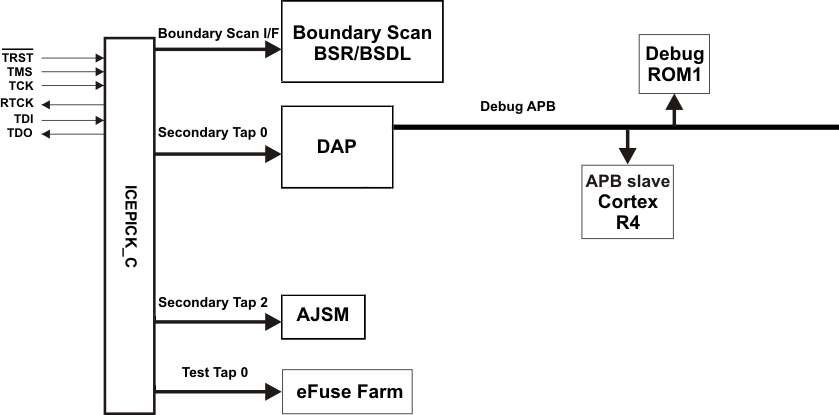 Figure 6-13 Debug Subsystem Block Diagram
Figure 6-13 Debug Subsystem Block Diagram
6.20.2 Debug Components Memory Map
Table 6-28 Debug Components Memory Map
| MODULE NAME | FRAME CHIP SELECT |
FRAME ADDRESS RANGE | FRAME SIZE |
ACTUAL SIZE |
RESPONSE FOR ACCESS TO UNIMPLEMENTED LOCATIONS IN FRAME | |
|---|---|---|---|---|---|---|
| START | END | |||||
| CoreSight Debug ROM | CSCS0 | 0xFFA0_0000 | 0xFFA0_0FFF | 4KB | 4KB | Reads return zeros, writes have no effect |
| Cortex-R4 Debug | CSCS1 | 0xFFA0_1000 | 0xFFA0_1FFF | 4KB | 4KB | Reads return zeros, writes have no effect |
6.20.3 JTAG Identification Code
The JTAG ID code for this device is the same as the device ICEPick Identification Code.
Table 6-29 JTAG Identification Code
| SILICON REVISION | IDENTIFICATION CODE |
|---|---|
| Initial Silicon | 0x0B97102F |
| Revision A | 0x1B97102F |
| Revision B | 0x2B97102F |
6.20.4 Debug ROM
The Debug ROM stores the location of the components on the Debug APB bus:
Table 6-30 Debug ROM table
| ADDRESS | DESCRIPTION | VALUE |
|---|---|---|
| 0x000 | Pointer to Cortex-R4 | 0x0000 1003 |
| 0x001 | Reserved | 0x0000 2002 |
| 0x002 | Reserved | 0x0000 3002 |
| 0x003 | Reserved | 0x0000 4002 |
| 0x004 | End of table | 0x0000 0000 |
6.20.5 JTAG Scan Interface Timings
Table 6-31 JTAG Scan Interface Timing(1)
| NO. | PARAMETER | MIN | MAX | UNIT | |
|---|---|---|---|---|---|
| fTCK | TCK frequency (at HCLKmax) | 12 | MHz | ||
| fRTCK | RTCK frequency (at TCKmax and HCLKmax) | 10 | MHz | ||
| 1 | td(TCK -RTCK) | Delay time, TCK to RTCK | 24 | ns | |
| 2 | tsu(TDI/TMS - RTCKr) | Setup time, TDI, TMS before RTCK rise (RTCKr) | 26 | ns | |
| 3 | th(RTCKr -TDI/TMS) | Hold time, TDI, TMS after RTCKr | 0 | ns | |
| 4 | th(RTCKr -TDO) | Hold time, TDO after RTCKf | 0 | ns | |
| 5 | td(TCKf -TDO) | Delay time, TDO valid after RTCK fall (RTCKf) | 12 | ns | |
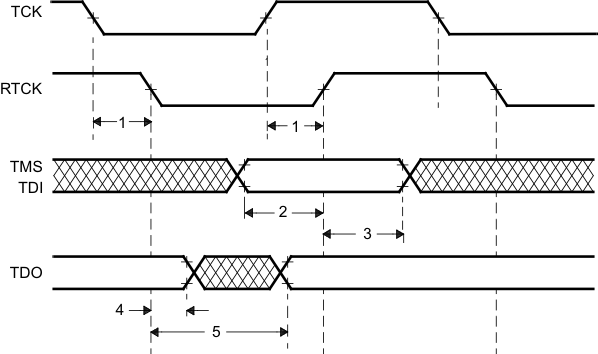 Figure 6-14 JTAG Timing
Figure 6-14 JTAG Timing
6.20.6 Advanced JTAG Security Module
This device includes a an Advanced JTAG Security Module (AJSM). which provides maximum security to the memory content of the device by allowing users to secure the device after programming.
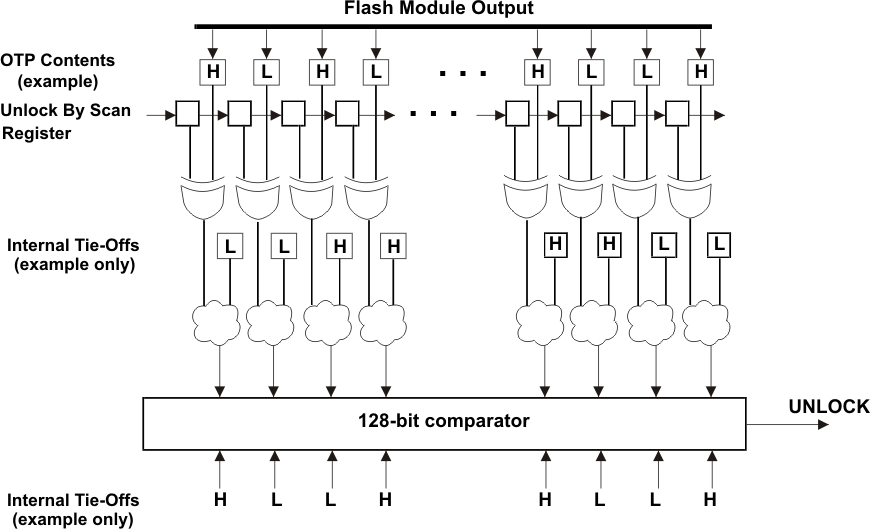 Figure 6-15 AJSM Unlock
Figure 6-15 AJSM Unlock
The device is unsecure by default by virtue of a 128-bit visible unlock code programmed in the OTP address 0xF0000000.The OTP contents are XOR-ed with the "Unlock By Scan" register contents. The outputs of these XOR gates are again combined with a set of secret internal tie-offs. The output of this combinational logic is compared against a secret hard-wired 128-bit value. A match results in the UNLOCK signal being asserted, so that the device is now unsecure.
A user can secure the device by changing at least one bit in the visible unlock code from 1 to 0. Changing a 0 to 1 is not possible because the visible unlock code is stored in the One Time Programmable (OTP) flash region. Also, changing all the 128 bits to zeros is not a valid condition and will permanently secure the device.
Once secured, a user can unsecure the device by scanning an appropriate value into the "Unlock By Scan" register of the AJSM module. The value to be scanned is such that the XOR of the OTP contents and the Unlock-By-Scan register contents results in the original visible unlock code.
The Unlock-By-Scan register is reset only upon asserting power-on reset (nPORRST).
A secure device only permits JTAG accesses to the AJSM scan chain through the Secondary Tap # 2 of the ICEPick module. All other secondary taps, test taps and the boundary scan interface are not accessible in this state.
6.20.7 Boundary Scan Chain
The device supports BSDL-compliant boundary scan for testing pin-to-pin compatibility. The boundary scan chain is connected to the Boundary Scan Interface of the ICEPICK module.
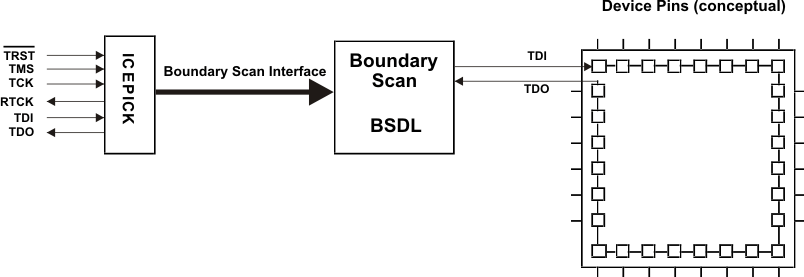 Figure 6-16 Boundary Scan Implementation (Conceptual Diagram)
Figure 6-16 Boundary Scan Implementation (Conceptual Diagram)
Data is serially shifted into all boundary-scan buffers through TDI, and out through TDO.